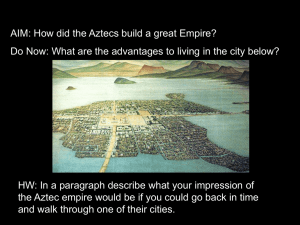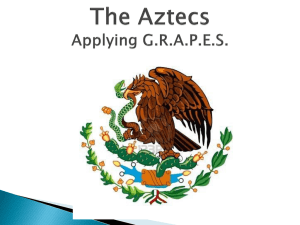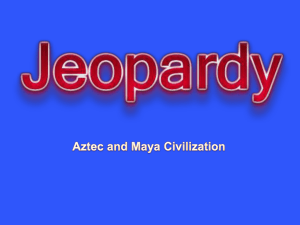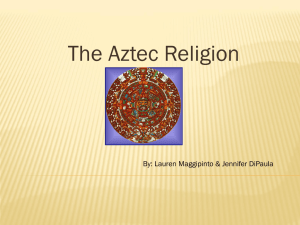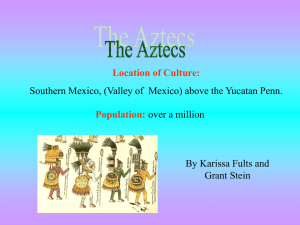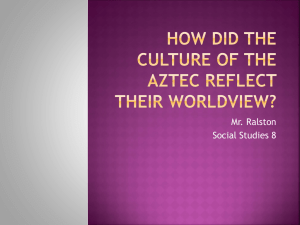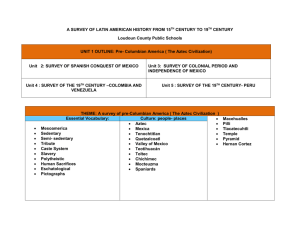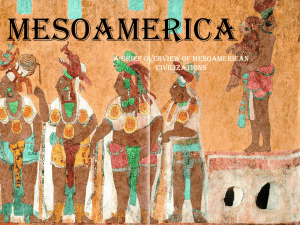Aztec Civilization
advertisement
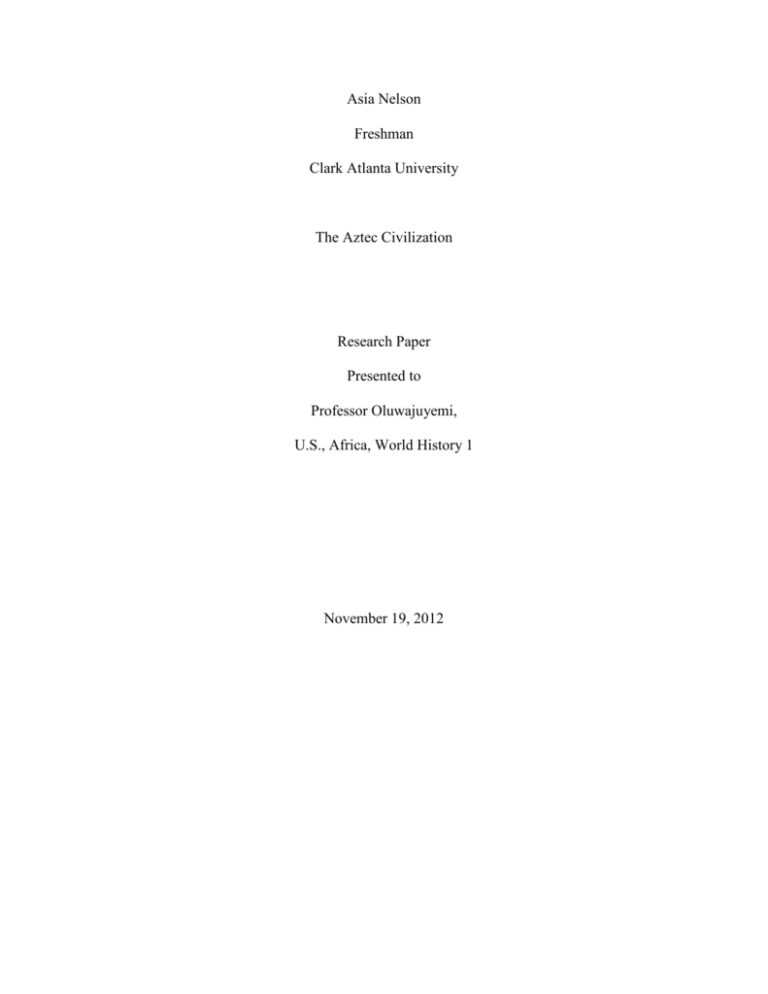
Asia Nelson Freshman Clark Atlanta University The Aztec Civilization Research Paper Presented to Professor Oluwajuyemi, U.S., Africa, World History 1 November 19, 2012 Asia Nelson A civilization is "a high level of cultural and technological development; more specifically, the stage of cultural development at which writing and the keeping written record is attained”1. The Aztec civilization existed from 1250 to 1485 AD in the valley of Mexico and originated from the ancestry of the Toltec’s empire. The civilization began when the nomadic Nahuatl-speaking immigrants migrated south to Mexico and assimilated with what was left of the Toltec society after the downfall of the Tula Empire. The Aztecs easily adapted to the characteristics of the Toltec’s rituals, gods, economic policies, kingship principles, and city planning.2 The Aztecs were well-developed and advanced society who is well known for their political structure, social pyramid, and religious beliefs. Although the Aztec empire is no longer around, some aspects of their civilization still managed to survive over time. Stretching over 80,000 miles in current day central and southern Mexico, the Aztec civilization composed themselves in many city-states known as the alteptl. Each alteptl was an organized community that had their own law, a well-defined boundary, and a tlatoani, a king.3 The Aztec empire was divided into about forty independent city-states and they all resembled the political structures composed into three offices: the tlatoani, cihuacoatl, and the tecuhtli. When ruling the city, these three offices of the government ruled permitting to what was acceptable within the state according to the nature of the universe and humankind.4 The tlatoani was the most important office of the empire. “The good ruler is a protector; He rules, take responsibilities, assumes burdens. He carries is subjects in his cape; he bears them in his arms. He governs; he is obeyed. To 1 Webster , Merriam. An Encyclopedia Britannica , "Merriam-Webster." Last modified 2012. Accessed October 28, 2012. http://www.merriam-webster.com/. 2 Smith, Dr. Michael E. Arizona State University, "AZTEC CULTURE: AN OVERVIEW." Last modified 2006. Accessed October 28, 2012. http://www.public.asu.edu/~mesmith9/1-CompleteSet/Smith-AztecCulture-WWW.pdf. 3 Dirk R. Van Tuerenhout, The Aztecs, (Santa Barbara, California: ABC-Clio, Inc., 2005), 123. 4 Marco A. Almazan, "The Aztec States-Society: Roots of Civil Society and Social Capital," Annals of the American Academy of Political and Social Science , 565 (1999): 166, 1 Asia Nelson him as shelter, a refuge, there is recourse. He serves as proxy, as substitute (for the deity)”5. A tlatoani’s office was combined with religious, political, and military aspects. The citizens of the empire believed that the tlatoani was a representative of god. The tlatoani were responsible for the protection of his citizens therefore he was the supreme military leader. His duties were to organized military campaigns, supervised the defense lines, and also solve criminal cases the lower courts could not resolve.6 When a ruler was overthrew or killed, he was replaced by someone with the same dynamic credentials elected by the noble staff. During this period of electing a new tlatoani, the cihuacoatl, the second most important office of the government, was in charge of the empire. During the transitioning of a new tlatoani, he was entitled the same duties as the tlatoani but outside of this period, the cihuacoatl was considered to be the prime minister or viceroy.7 He was responsible for keeping the empire together and standing in as a representative of the tlatoani when he is out of the city. The tecuhtli was the least important role within the Aztec’s empire. Made up of a noble council and bureaucrats, they also participated within the administration of the city. After the fall of the Aztec empire, this political structure was still being practiced up until the eighteenth century under the rule of the Spaniards. With a population about 5 million people, the citizen of the Aztec’s empire were divided among the alteptl. Each alteptl had a social structure which was divided into two main groups: the pipiltin and the macehualtin. The social structure within these two groups differed depending on which city a person resided in. According to the Aztec’s capital city Tenochtitlan, the pipiltin was the noble class and consisted of a high-ranking chief, important political 5 Nigel Davies, "The Civilization of the American Indian series," The Aztec Empire, Vol. 187, ed. Comittee on Production Guidelines for Book Longevity of Council on Library Resources, Inc. (Oklahoma: University of Oklahoma Press, Nowman, Publishing division of the University, 1987). 6 Dirk R. Van Tuerenhout, The Aztecs, (Santa Barbara, California: ABC-Clio, Inc., 2005), 156 7 Dirk R. Van Tuerenhout, The Aztecs, (Santa Barbara, California: ABC-Clio, Inc., 2005), 123. 2 Asia Nelson positions, religious leaders, and military officials whereas the macehualtin consisted of majority of the Aztec civilization such as traders, farmers, and merchants.8 These social classes were not hereditary and a commoner could easily rise to power through heroism in battle or as an effective religious leader. Within these two major social classes, other social structures existed as well. At the top of the pipiltin’s class was the king, also known as tlatoani.9 His duties involved governing the people and expanding the power of the empire. Under the tlatoani was a council of nobles made up of well trusted and loyal lords in charge of the Lord’s house called the tecuhtli.10 The tecuhtli were supported greatly by the people and were also a part of the ruling process with the tlatoani. At the bottom of the pipiltin class were the offspring of the talatoani and tecuhtil. Tlahtohcapilli, the highest ranking offspring, are the children of tlahtoani. Following the tlahtohcapilli was tecpilli, children of the teuctli. Tlazohpilli, sons of a legitimate wife, and calpanpilli, sons of a concubines, were also acknowledge within the noble class.11 The pipiltin class was only ten percent of the entire population therefore majority of the citizens from the Aztec civilization falls within the macehualtin class. This class was so huge that it was easily divided into three social classes such as the calpulli, tlalmaitin, and the tlacotin.12 The calpulli class was the highest ranking among commoners. They were people who owned land and were considered to be the ward headman that represented their neighborhood before the government. Next in line was the tlalmaitin. The people of this class were required to pay tributes in goods and were laborers for the calpulli class. At the bottom of the pyramid were the tlacotin, who were slaves. The slave class consisted of criminals and people who could not pay their taxes. 8 Dirk R. Van Tuerenhout, The Aztecs, (Santa Barbara, California: ABC-Clio, Inc., 2005), 123. 9 Smith, Dr. Michael E. Arizona State University, "AZTEC CULTURE: AN OVERVIEW." Last modified 2006. Accessed October 28, 2012. http://www.public.asu.edu/~mesmith9/1-CompleteSet/Smith-AztecCulture-WWW.pdf. 10 Dirk R. Van Tuerenhout, The Aztecs, (Santa Barbara, California: ABC-Clio, Inc., 2005), 124. 11 Dirk R. Van Tuerenhout, The Aztecs, (Santa Barbara, California: ABC-Clio, Inc., 2005), 123. 12 Smith, Dr. Michael E. Arizona State University, "AZTEC CULTURE: AN OVERVIEW." Last modified 2006. Accessed October 28, 2012. http://www.public.asu.edu/~mesmith9/1-CompleteSet/Smith-AztecCulture-WWW.pdf. 3 Asia Nelson Although they were slaves, they were allowed to own property, buy their freedom, and even marry a free person. Children born of the slaves are born free. In addition to politics and the social hierarchy, religion played a huge role within the Aztec’s citizens’ lives. The Aztec religion can be broken down into three concepts: the variety deities, rituals performed, and the belief in an afterlife. The Aztec religion was polytheistic and had over one hundred gods and goddesses. To simplify the deity, the gods were divided into three groups based on similarities. The first group of gods consisted of creative and fatherly figure gods. Ometeol, the most important god, is a part of group one. Ometeol was dual-god meaning he had female and male principles. Creator of all the other deities, Ometeol lived in the uppermost part of the thirteen levels of heaven.13 Gods who share principal roles like rain, moisture, and agriculture fertility are all a part of group two. Centeotl, the maize god, played a significant role within the Aztec civilization because maize was considered one of the staple foods within Mesoamerica and brought in wealth for the economy.14 The last groups of gods shared principle roles of war, sacrifice, and blood nourishment of the Sun and Earth. Tonatiuh was the sun god. He was able to make the crops grow by providing warmth and fertility.15 The deities of the Aztec civilization were anthropomorphic. They quarrel, fight, and get jealous easily. Not only to keep the gods happy, the citizens of the Aztec empire performed rituals to release them of their sins so they can become worthy in the afterlife. The most common and important ritual as an effort to please the gods is animal and human sacrifices. “Humans were put to death not only by excision of the heart but also by decapitation, having the throat cut, being thrown into fire, being scratched, … flaying in the so-called 13 Dirk R. Van Tuerenhout, The Aztecs, (Santa Barbara, California: ABC-Clio, Inc., 2005), 180. 14 Dirk R. Van Tuerenhout, The Aztecs, (Santa Barbara, California: ABC-Clio, Inc., 2005), 180. 15 Dirk R. Van Tuerenhout, The Aztecs, (Santa Barbara, California: ABC-Clio, Inc., 2005), 183. 4 Asia Nelson gladiatorial sacrifice, being shot with arrows, drowning, being buried alive, and being hurled down from the top of a pole or a pyramid.”16 The people selected to be sacrificed for the gods were usually slaves who impersonated deities or war captives. Another ritual performed to please the gods instead of sacrifices was offerings. Some of these offerings consisted of crops, temples, and art. Depending on how well the Aztec’s citizens worship the gods and lived their lives determine the status of them in their afterlife. The Aztecs believed that the universe is divided into three levels: the heavens, the world they lived on, and the underworld. Heaven has thirteen levels all separated by floors. The lowest are comprised of moon, clouds, stars, sun, Venus, comets, and the colors green, blue, black, and blue; the higher levels are contain the gods and the colors white, yellow, and red.17 Just like the heaven, the underworld is also in layers. Instead of thirteen, the underworld is composed of nine layers. The surface of the Earth was considered to be level one while Mictlan was considered to be level 9.18 According to the Aztecs, when a person dies, their body and souls depart from each other. Depending on the cause of death and how the burial procedure is performed, their souls is could go to three places.19 Place number one, when people who died in the battlefield, sacrifices, or in childbirth were destined to go to the house of the suns in heaven. Place number two, is associated with the god of Tlaloc meaning the death would have to do with some form of water considering Tlaloc is the god of rain. The final destination would be Mictlan but before the soul reaches there, it would have to complete a series of tasks for four years. Over a 200-year time span, the ancient Aztec civilization was able to develop from a group of nomadic individuals into one of the greatest ancient civilizations within the world. The 16 Michael Graulich, "Aztec Human Sacrifice as Expiation," Chicago Journals, 39, no. 4 (2000): 353, 17 Dirk R. Van Tuerenhout, The Aztecs, (Santa Barbara, California: ABC-Clio, Inc., 2005), 185. 18 Dirk R. Van Tuerenhout, The Aztecs, (Santa Barbara, California: ABC-Clio, Inc., 2005), 185. 19 Dirk R. Van Tuerenhout, The Aztecs, (Santa Barbara, California: ABC-Clio, Inc., 2005), 123. 5 Asia Nelson Aztec Empire is known for other accomplishments besides the political structure, social hierarchy, religious beliefs, and arts. Due to their lack of technological equipment such as the wheel and guns, the Aztec civilization is very intelligent and sophisticated because of the many accomplishments they achieved. The legacy of this ancient civilization is expressed through intellectual accomplishments. They developed a number and writing system; advanced mathematical system and complex calendars composed of 260 and 365 days; established education and legal systems; was able to diagnose and cure illness. All of these accomplishments are being practiced in many countries outside of Mexico such as the United States, Great Britain, and Spain. The Aztec empire was a huge impact on the world. 6 Asia Nelson Bibliography Almazán, Marco A. "The Aztec States-Society: Roots of Civil Society and Social Capital." Annals of the American Academy of Political and Social Science. 565. (1999): 162-175. Davies, Nigel. The Civilization of the American Indian series. The Aztec Empire. Vol. 187. Edited by Committee on Production Guidelines for Book Longevity of Council on Library Resources, Inc.. Oklahoma: University of Oklahoma Press, Norman, Publishing division of the University, 1987. Graulich, Michael. "Aztec Human Sacrifice as Expiation. “Chicago Journals. 39. no. 4 (2000): 352-371. Smith, Dr. Michael E. Arizona State University, "AZTEC CULTURE: AN OVERVIEW." Last modified 2006. Accessed October 28, 2012. http://www.public.asu.edu/~mesmith9/1CompleteSet/Smith-AztecCulture-WWW.pdf. Van Tuerenhout, Dirk R. The Aztecs. Santa Barbara, California: ABC-Clio, Inc., 2005. Webster , Merriam. An Encyclopedia Britannica , "Merriam-Webster." Last modified 2012. Accessed October 28, 2012. http://www.merriam-webster.com/. 7

